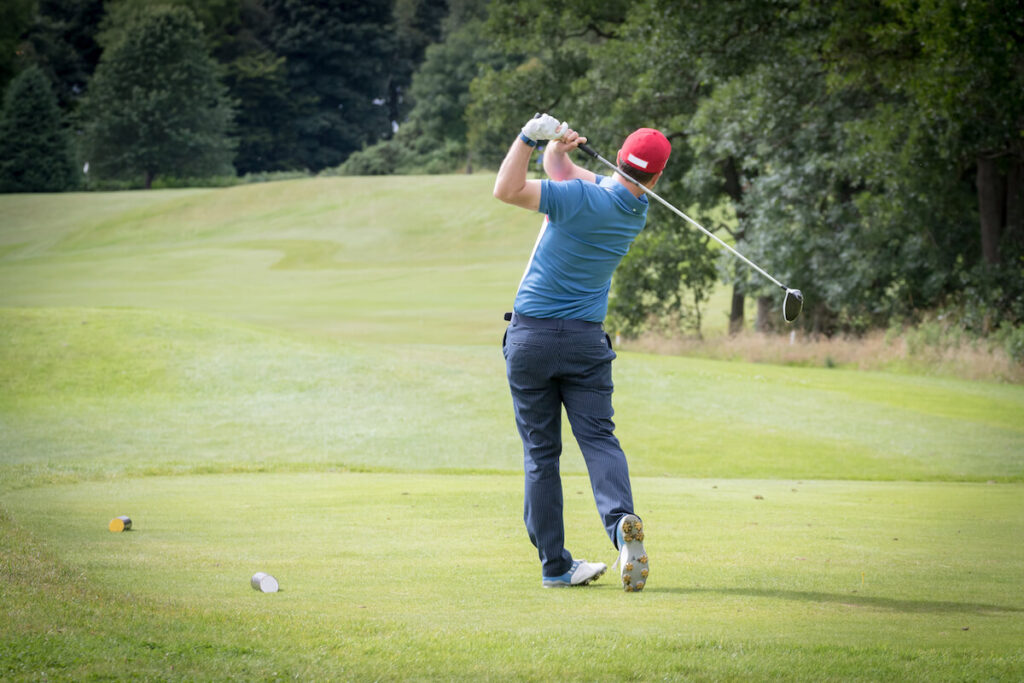How to Hit a Draw in Golf: A Beginner’s Guide
Posted by

Imagine you are standing on the tee box, overlooking a beautiful fairway. You take a nice, easy swing with your driver and hit a shot that gently curves during its flight path, landing right in the middle of the fairway. Sounds nice, right?
If you’d like to work the above scenario into your game, you may be interested in learning how to hit a draw. A draw is a shot that naturally curves from right to left for a golfer who is right-hand dominant. If you have a left-handed swing, a draw would curve from left to right. Learning to hit a draw is advantageous because it has a penetrating ball flight — one that is well-hit with a low trajectory — allowing you to pick up yards while staying on target.
We’re here today to help you learn how to hit a draw in golf. Specifically, we’ll cover what this type of golf shot is, how to hit it, and why doing so is important. We’ll also outline how a draw is different from a fade. By the end of this article, you should have a much better understanding of what you need to do to start working a draw shot into your game.
Defining a Draw — The Basics
A draw is a shot that, for a right-handed player, starts right of the target and “draws” back to the center line. The center line is the direct line between you and the target. You may also see this referred to as a target line.
The above is the opposite for left-handed players. If you swing from the left side, your ball starts toward the left of your target. Then, the ball curves back toward the target line.
It’s worth noting that the curve on a draw is gradual. It is not a hook or a shot with a sharp ball flight. You should not have to be aiming way left or right to place the ball in the middle of the fairway. Instead, you should be lined up toward your target, with your golf swing naturally allowing a draw to occur. Having said that, let’s take a closer look at how to hit a draw in golf.
How to Hit a Draw in Golf

If you want to hit a draw, you’re going to need to focus on two things:
- Keeping a square club head at impact
- Having an inside-to-square swing path
If you have an open club face, you’ll likely end up slicing the ball. If you have a closed club face, you’ll hook the ball. So, be sure to keep the above two concepts in mind when aiming to draw your golf ball. From there, learning to hit a draw is dependent on you remembering the fundamentals of your golf swing sequence.
A good draw starts during your setup. Take your normal starting position. For a standard drive, the ball position should be just off your left foot. However, if you’d like to draw the ball, you should drop your right foot back by approximately one inch. Your left foot should now be in front of your right foot if you’re a right-hander. If you’re left-handed, reverse the above.
The next component of the draw is the backswing. If you’re able to maintain a square club face during your backswing, you’ll be more likely to maintain a square club face throughout the duration of your golf swing. When you make it to the takeaway — the momentary pause between your backswing and downswing — your club face should be pointing at the ball.
Following the takeaway is the downswing. If you are able to drive your lower body and shallow the golf club, you may find that you naturally have an inside-out swing path.
One good golf tip to remember when training is to visualize a clock in front of the ball. If you are looking to hit a straight shot, you may hit the ball at “12 o’clock.” However, for a draw, you’ll instead want to target hitting the ball at “1 o’clock.” But remember what we said earlier — you’ll want to have a square club face angle.
Lastly, you’ll want to maintain a strong grip throughout the duration of your swing. If you rely on your wrists, you’ll likely end up putting side spin on it, creating a slice. If you maintain strong wrists through your swing, the ball will start to the right of your target but gradually settle in on your target line.
Why It’s Important to Learn How to Hit a Draw
Going to the driving range and learning how to hit a draw in golf will start to separate you from high-handicappers. The perfect draw is advantageous for a few reasons.
First and foremost, a draw puts less spin on the ball. Oftentimes, shots with lower spin rates will travel further. Additionally, the ball flight has a lower trajectory, allowing you to have a penetrating ball flight. A penetrating ball flight will cut through wind a bit more than other shots, which can help you pick up yardage in tough conditions.
Second, a draw can help you with difficult golf course designs. For instance, let’s say that you are playing a dogleg left, meaning that the green is up around a sharp bend on the left-hand side. A draw for right-handed players would allow them to potentially cut the corner and put them in a better position for a green-in-regulation. (Left-handed players in this case would need to learn how to hit a fade).
How a Draw Is Different Than a Fade
Draws and fades are two similar shot-shaping techniques. As discussed previously, a draw for a right-handed player will gradually curve from right to left. A fade is the opposite type of shot, in that it naturally curves from left to right (the opposite, of course, is true for left-handed players. A fade for lefties is a swing that moves right to left).
In this case, the club path needs to be out to in. A fade tends to produce a higher ball flight with more spin, meaning it will bounce and roll less. This is different from a draw, which tends to have a lower trajectory and roll more. Having both consistent fades and consistent draws in your bag will add versatility, allow you to play around obstacles on the course, and hit more greens.
Whether you’re looking to learn how to hit a draw or a fade, you’ll need to understand your golf swing. If you’re comfortable enough with your swing, you’ll then be able to change your club path to inside-out or outside-in. Golf is a game that requires patience and practice. This is certainly the case when learning how to shape your shots via draws and fades.
Start Working to Implement a Draw Into Your Swing

If you’re looking to improve your golf game, one of the things you may want to work on is learning how to hit a draw. Knowing how to hit a draw in golf is important, as it could potentially help add more yardage and consistency to your shots. Graduating from straight shots to draw shots is a giant step in learning how to play better golf.
Having said that, learning how to hit a draw can be challenging. It’s something that even PGA Tour players work continuously to improve. The swing tips provided in this article are an excellent way to get started, but it’s going to take a bit of practice to start feeling comfortable with the swing needed to produce a draw.
One way to gain better golf instruction is by using Skillest. Skillest matches you with online coaching and teaching professionals to help improve all aspects of your game. Whether you want to hit a draw or would like to improve your chipping and short game, find a coach on the Skillest platform to get the help you need.
